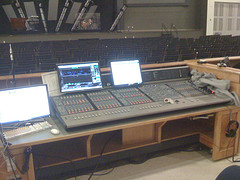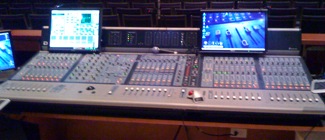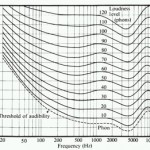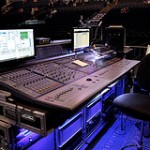
Changing Lanes
There’s been a bit of a running joke between myself and a some of my VENUE D-Show brethren for a while now. It generally goes something like this:
Me: Hey, I have a question I’ve been meaning to ask you. How do you mix with the sidecar on the wrong side?
Robert: I was going to ask you the same thing.
For those of you who don’t know what I’m talking about, the VENUE’s D-Show control surface is typically configured with two units: the main unit, and a sidecar. The main unit and sidecar come as two separate pieces, but most folks connect them together to create one console. The proper way of assembling the two units is to place the sidecar on the left of the main unit. I say it’s proper because even the screen printing on the surface numbers the input channels this way. I’ll call it designer’s intent. This is the D-Show configuration I’ve mixed on for the last 5 years.
However, over the last year or so I have seen a growing number of users opting for the sidecar on the right side of the main unit, and I don’t think I’ve been conservative in expressing my sidecar feelings to those folks. But standing over Robert Scovill’s shoulder on the latest Tom Petty tour and literally watching him mix on this setup [yes, there’s a post coming on that] convinced me that maybe these right-side sidecar users might be on to something, and maybe it was worth investigating and experimenting with a bit.
Now, the sidecar thing on the VENUE poses some interesting challenges because of the way the main unit is setup. If you place the sidecar on the left, all of your inputs land to the left of the master section. If you’re like me and spend a lot of time mixing on VCA’s, this can create a challenge because the input faders on the far left of the console are out of reach. A lot of weeks this isn’t a big deal because thanks to stereo channels I can typically fit most of the inputs I’ll want to grab on the top bank within reach. The new VCA spill feature also offers a way of bringing things in closer to the master section. So the sidecar on the left is a valid setup, and as I mentioned above I’ve worked that way for five years.
However, something I’ve noticed is as our input counts have expanded a bit there are times where it can get interesting trying to get everything I want within reach. For example, our Night of Worship last week featured four vocalists alternating leads with three of the four vocalists also on an instrument. Typically when I have singers playing instruments, I want those instruments within reach because sometimes they require a little more attention than musicians focused only on their instrument. I would traditionally place these on the 7-8 inputs immediately to the left of the master section with a left sidecar setup. As a result a some of the other instruments end up on Bank B which is fine. Banking is a way of life on digital consoles. The hard part of this, though, is those Bank B instruments will have to land on the sidecar so that I can keep my vocals up at all times. When I’m mixing in the middle of the main unit with my left hand on the vocals and my right hand on the VCA’s, it’s hard to reach the sidecar. I know I have to take a hand off something to get at the stuff, but in the thick of the moment vocals typically lose. Again, not a deal breaker–I mixed this way for five years.
When I started looking at the idea of jumping on the sidecar-right bandwagon, I visited our Buckhead campus where they have a D-Show with the alternate setup. As I loaded up my template and starting moving channels around into some potential configurations, the thing I noticed was with the sidecar on the right I found myself standing in the middle of the combined console which put more input faders within reach. I was only standing a foot over from where I mixed with the left-sidecar setup, but I found I could now reach every fader on the console. The far outside faders require stretching, but I can comfortably reach 16-18 input faders where I could previously reach maybe 8-10 comfortably. The faders that are a reach still felt closer, though, and required me to shift very little from my mix position to tweak compared to the previous setup. I was also happy to have the master section right in front of me where it typically landed mixing back in analog days. So basically after a little bit of experimenting at Buckhead I decided I wanted to take a stab at changing things up.
This was a big decision because it’s not an easy process to move the sidecar. You pretty much have to open up every panel on the surface, and there are a TON of screws. I remember the first time Bob and I put the VENUE together back in Chicago took some time. This time around, though, it took myself and two of our volunteers about 90 minutes to do the switch which I didn’t think was too bad. It also made me feel a little better about the whole idea because I knew if the setup didn’t fly, we would eventually have to change it back.

D-Show 2010: Sidecar on the Right
Fortunately, I’m liking it so far, but it’s definitely a little challenging since I have a lot of muscle memory from working the other way. Here are a few things I noticed from spending about three full days mixing on the new setup:
The bottom-line is adjusting to the new configuration didn’t take me nearly as long as I thought it might which was a good sign considering my last attempt at this didn’t fare so well….. It helped that I had thought my input layout through pretty well ahead of time so finding things felt much more intuitive in most cases. EQ controls on the left was really my biggest downside, but it’s not a deal breaker for me and is something I’m already starting to adjust to. Feeling like I have better access to the entire console was really the biggest win for me, and I’m looking forward to playing with this more over the coming weeks. It’s maybe still a bit of an experiment, but my first time out was good so my plan is to stick here for a bit and see how we feel in a few months.


 Previous Post
Previous Post Next Post
Next Post



I just wanted to say publicly, I told you so…
🙂
Much love bro.